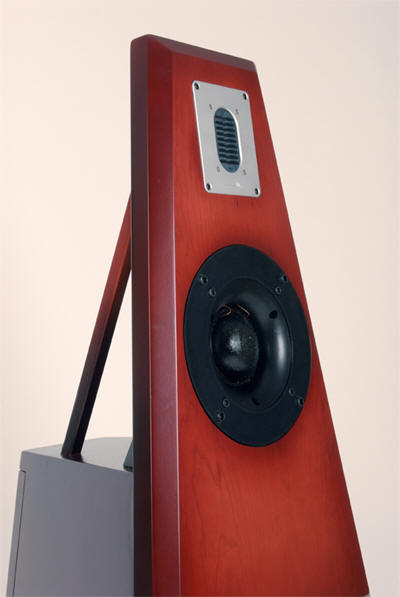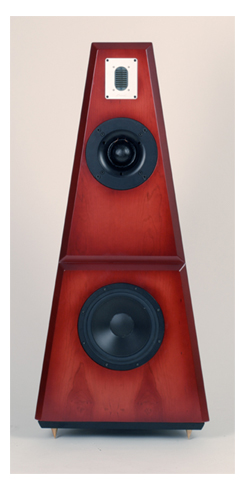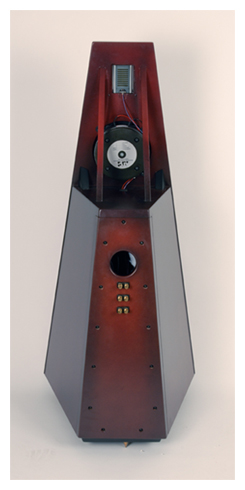
You are reading the older HTML site
Positive Feedback ISSUE
march/april 2007
tetra
606 loudspeakers - Amorous Wholeness
as reviewed by Jim Merod

|
Tetra There
The first time I heard Tetra's new flagship 606 speakers was in Herbie Hancock's studio in Los Angeles. I was invited to bring recent concert recordings I'd made which featured the Maestro with Wayne Shorter in a reprise of their One + One album on Verve. I'd heard how good Herbie's studio sound was, but I was not prepared for its ultra-audiophile quality. Herbie Hancock is "the real deal" on several levels: as a man, as a musician, and as an audio enthusiast. Spending the bulk of an afternoon with the Maestro in his studio constitutes cheerfulness seldom fantasized.
Herbie Hancock and Adrian Butts of Tetra
First, a word about Herbie Hancock. Never in six and a half decades I have spent on this planet, have I sustained time with anyone as radiant, genuinely joyful, intelligent, relaxed, and welcoming (fun to be with immediately and without reservation) as Herbie Hancock. He is a man who—and I say this not to embarrass him—possesses realized self-affirmation along with the inclusive embrace of others. These traits are found only within extraordinary human beings such as the Dali Lama. I'm sure Herbie would disavow my assessment, but differences of outlook notwithstanding, I'll attest to the unassailable fact that Herbie Hancock is a unique and special human being as well as a magnificent artist.
Second, Herbie's audio set up is a killer. A large Chord stereo amplifier, a pairing that's extremely relaxed and musically seductive, drives his Tetra 606 speakers. I was surprised (and pleased) to hear my discs reproduced with a combination of immense dynamic range and exquisite textural delicacy. Sitting in Herbie Hancock's studio—with its many keyboards and large professional mixing board making a generous room into a cozy, intimate listening space—was delightful and beguiling. The Maestro's company is rare, deeply engaging, and instructive. I could blowse here at length about our shared observations of his former boss and colleague Miles Davis. But not now.
Tetra Here
Soon after my initial encounter with the beautiful 606 speakers, I found a pair residing in my main mastering rig. The swiftness of that request's fulfillment made me feel like the dangerous turban guy with a genii's lamp. Make a wish. Rub the lamp. Whoosh !
The first thing to note is that these red-hued semi-triangular creations carry Tetra's stylistic cache. My first acquaintance with Tetra was a decade ago or so, putting me in front of Adrian Butt's brilliant but bizarre looking "Live" speakers. Their avant-garde design gave them the appearance of rocket ships on launch pads. Nothing about their performance was ungainly or unearthly; only their radically triangular structure suggested that "blast off" may be near at hand.
The 606 speakers are less far out in appearance. In fact, my significant other finds them visually appealing. After so many years looking at me, just about anything's a reprieve, but many audio instruments have come and gone with her good riddance waving sayonara. That Tetra's 606 have a distinct sculptural elan able to surmount rigorous aesthetic scrutiny suggests that the classic aim, to merge form and function, has been accomplished here.
What It Is
I'll note at the outset that these are difficult speakers to fully assess. I'm well aware that sound is merely "sound". Any reviewer with adequate experience ought to be capable of approaching the glorious if not mysterious universe of sound and music with confident discernment. That's not the problem I'm alluding to here. The Tetra's 606 speakers are very subtle.
I'll slice to the bone. I was stunned and pleased by the 606's performance in Herbie Hancock's studio. Herbie was also pleased as noted in our afternoon together. Perhaps, in my studio, reviewer's hat squarely set, my capacity to be pleased and stunned will disappear as squinty-eyed attention erodes leisure's relaxation. However I parse this difference, I'll note that the 606s surprised me here, too, surviving scrutiny and suspicion.
I ran my usual squad of reviewing discs at them and enjoyed everything I heard. Soberingly, I heard what seemed like a degree of audio relaxation and sonic ease seldom encountered in reproduced music. There's nothing negative about that fact, but the spooky quality of its liminal appearance as a sub-sonic partner to my listening haunted me for a week or so, whereupon I did the obvious thing: drove the 606s, disc after disc, with one 24-96 master recording after another—raw, unmastered music, exactly what hit the discs during recorded performance.
Voila ! The enigmatic "extra" quality that previously seemed to "shadow" each commercial album—the inaudible, but felt surplus of ease that I'd experienced (strangely)—now emerged with tactile clarity.

Compressed recordings, no matter how slight the compression ratio, "squeeze" sound and add sonic force and vividness. That process, even with the best compression quality, enhances dynamic impact but creates a somewhat less than truthful sound stage presence. In sum, compression (to an extent sometimes overlooked) replaces the inherent relaxation, temporal pace and sonic ease of sound in its original ambient space—replaces those innately musical properties with heightened, strengthened sonic force. The compressing of sound partially robs it of ambient accuracy if, by that term, you recognize the actual impact of any note or musical phrase upon the ear to be a direct function of the ear's placement in proximity to the physical activity of musical performance. In actual performance space, hearing is dependent upon the acoustic envelope that carries sound and music. This "envelope" is what gets somewhat exaggerated or deformed by compression.
A debate can easily be generated regarding the positive aspects of gentle compression loading on ambient-recorded music. A slight degree of compression can actually have the effect (i. e., create the sonic illusion) of bringing the ear closer to a musical performance. To that end, compression not only enhances the vivacity of listening, but also reinforces the sense of space and air and ambient acoustic detail.
The outcome of that trade off comes to this: during many of the most intense and pleasurable listening moments one is likely to enjoy, the accuracy of "actual musical space" is likely to have been compromised for the sake of sonic impact, reinforced vividness of detail, and the experience of enhanced musical drama. Nothing there is onerous. Although I'm devoted to the maximum capture and recreation of ambient truth, the facts of sonic accuracy and spatial eccentricity often decide against one's theoretical dedication to an audio ideal. They argue for slight enhancements that add to listening pleasure. Believe me, when you work in the trenches of live sound and "in performance" music production, you often find urgent need to climb out of disadvantaged ambient troughs in order to save the majesty musicians strive for as well as to assure repeatable, joyful listening.
What I'm Talkin' About
When I listen to uncompressed master recordings with the Tetra 606s, the ambient space that accompanies original direct-to-two track capture appears naturally, unobtrusively but audibly. It appears as the inevitable acoustic companion to live music. Let me refine this a touch.
 Each location in which live concert
performances can be recorded has its own "acoustic footprint".
Audiophile cognoscenti have known for decades how different Symphony
Hall in Boston sounds in distinction to Carnegie Hall in New York. Each
major opera house in the world may have been designed with a precise
acoustic aim—to emulate older, decidedly beautiful ambient enclosures.
However, each has its own, wholly individual, sonic qualities.
Each location in which live concert
performances can be recorded has its own "acoustic footprint".
Audiophile cognoscenti have known for decades how different Symphony
Hall in Boston sounds in distinction to Carnegie Hall in New York. Each
major opera house in the world may have been designed with a precise
acoustic aim—to emulate older, decidedly beautiful ambient enclosures.
However, each has its own, wholly individual, sonic qualities.
Listening with thoroughgoing suspicion and careful attention to the Tetra 606s took on a radically new dimension when I assessed their reproductive characteristics via 24-96 master discs. The use of self-made recordings always accompanies my review activity, but the difference in this instance has been the friendly way the 606s "hear" and deliver ambient acoustic information. A point in specific here regards several piano recordings I've made in the last twelve months or so: Mike Garson and Herbie Hancock playing Fazioli grand pianos.
Perhaps the most startling quality that Fazioli pianos carry with them is an utterly compelling deep bottom end that essentially redefines one's expectations for low octave pianistic sound. In a word, Fazioli's deep voicing carries luxurious sonic grandeur that, in my estimation, is not equaled by any other piano (including the famous Bosendorfer, with its extra low-end octave). The unmastered, original sound of Herbie's low-end touch and Mike Garson's bottom octave thunder on Fazioli pianos—played during concert performances in three widely divergent ambient spaces—reveal not merely the piano's impressive acoustic majesty, but display each hall's reverberant detail and sonic decay.
Listening to these recordings gave me new insight into the 606s character and also resolved my sense of their glorious strangeness. What is "strange" about these speakers is their unusual capacity for reproducing the subtlest (most delicately gorgeous) sonic traces in uncompressed high-resolution live music capture. Believe me, there's nothing wrong with how these speakers handle, say, the vocal uplift of Sinatra at the Sands or a brooding Shostakovich string quartet. Through the 606s, Beethoven's "Ode to Joy" will thrill even the least freedom-loving listener. I merely note, with renewed respect, their ability to replicate nearly indistinct sound-shaping qualities of ambient sonic structures.
Conclusion
All of this stops short of stating the full character of these boldly subtle speakers, clearly Adrian Butts' most remarkable sonic creations to date. What makes the 606s a "state of the art" speaker in my judgment is their audio footprint, from top to bottom. Several instances may suggest what I mean.
My lady was tooling around in the garden soon after the 606s were placed in the main listening rig. She does not dwell on equipment swapped in and out on a fairly steady basis, so the 606s earned her instant, but not overdrawn approval for their lovely design. She enjoys beautiful objects in her world (despite my constant source of visual pollution), so I was pleased that these companions would not be cause for consternation.
Fine and good, but I was not prepared for her startled assertion one day as she worked in the garden right outside our open front door (this is California, remember: winter's often a rumor). "That sounds like Mundell Lowe playing his guitar right in the living room," she averred.
She was right. I'd just put on a master of the legendary guitarist, recorded a few months earlier precisely there in the living room, only a few feet from where the speakers were now reproducing his guitar touch. "Spooky, isn't it?" I yelled through the open portal, only to find her (with a somewhat agog look) coming inside to sit and listen!
That, my friends, is a rare occurrence. Our household gardener extraordinaire (and resident shit detector) was literally attracted to the "liveness", to the veracity of Tetra's sound. "I like these speakers," she muttered. That, ladies and gents in the jury box, is genuinely a first here.
A few weeks later, my dorkwad pal, Mumbo Jumbo, stopped by to filch a bottle of Chardonnay. "Sit down and listen for a minute while I get your wine," I insisted. He stayed more than two hours, asking me one question after another about why he heard so much detail and what exactly this or that extraneous audio fragment meant. In a way I regretted demanding him to enjoy the 606s since I had work to carry out. Good ol' Dorko had nothing to do except haunt me with naiveté. As it turned out, that session generated audio interest in a previously near stone-deaf, anti-audio guy. Soon after, he bought a mid-priced sound system. While his new set up is exactly what any audiophile would flee, Dork's got himself a new hobby: listening to music after a thirty year lay off.
Just two weeks ago, a talented amateur musician (a pianist) came by to pick up demo recordings from his recital. I invited him to listen to himself on the 606s. Perhaps no comment sums up the sonic pedigree of these speakers better than his: "This is exactly how the piano sounded when I played it that day!"
Over And Out
I've been more than impressed with the authority by which these speakers present what I'll call the "amorous whole" of well-recorded music. There's an erotic quality in gorgeous music and compelling sound. Now and then one enjoys magical sound and profound music in superior halls with superior musicians—Herbie Hancock on a Fazioli grand piano with nothing to diminish musical glory. The task of live recording work is to come as close as technically possible to capturing that magic with its complex delicacy and dynamic truthfulness.
Tetra's 606 speakers are among the best I've heard at any price. They are exquisite in their ability to render the "amorous whole" of music's elusive beauty, dignity, and emotional enchantment. Jim Merod
606 loudspeakers
Retail: $33,000 pair
Tetra
web address: www.tetraspeakers.com
